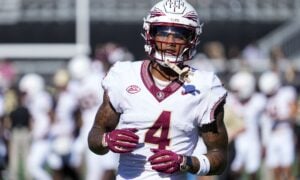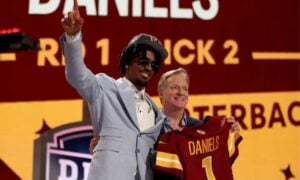2024 Off-Season Mock Drafts: Impact of the NFL Scouting Combine

The NFL Scouting Combine took place almost a month ago. It was one of the most closely watched events of the NFL off-season for both fans and fantasy degenerates alike. Relative to years past, there were very few underperformers at this year’s combine. Typically, we get several obvious busts, and that causes them to plummet in rankings and ADP. However, this year, more than anything, we had players meet or exceed the expectations placed on them heading into the combine.
DLF’s February mock drafts took place approximately three weeks before the combine and were followed by the March mocks which were conducted immediately after the combine was complete. I’m going to compare and contrast the two months of mock draft ADP data and see who is moving up, and who is sliding down.
(Authors note: I used the superflex ADP for quarterbacks only. I used the single-QB ADP for all other positions.)
Quarterback
Ho hum, move along, nothing to see here. The top four have been locked in for months, and in reality, the top seven have been locked in. Caleb Williams, Jayden Daniels, Drake Maye, JJ McCarthy, Bo Nix, Michael Penix, and Spencer Rattler will only see their rankings shift if we get a shockingly unforeseen shift in their NFL Draft capital.
The two notable risers were Joe Milton and Kedon Slovis. In February’s superflex rookie drafts, Milton was 57th overall, as QB11. After his bomb-slinging showing at the combine, his rise in ADP isn’t surprising. When March’s mocks were complete, Milton was 44th, as QB8. Where he fits in the NFL is anyone’s guess, but his landing spot could make him a more (or less) intriguing option. On the other hand, I don’t Kedon Slovis did anything in particular to raise his draft stock except exist. He went undrafted throughout February and is now QB12, 55th overall in this class. I don’t watch any college football, and I remembered Slovis tossing 30 touchdowns for USC as a true freshman back in 2019. He showed up at the combine, and the fantasy community said “Oh yeah, this guy” and he squeezed into mocks. I don’t see a world where either one of them is ever a factor for fantasy leagues.
On the flip side, there were two notable fallers; Michael Pratt and Sam Hartman. Hartman was an irrelevant QB9 and fell to an even more irrelevant QB13. Pratt was QB8, but Milton jumped over him and now he is QB9, but overall he dropped five spots in the draft from 44th to 49th. Pratt was climbing up some fantasy draft boards, I even saw him as high as QB5 for some people, but that upward trajectory seems to have been halted. I thought Pratt had some potential, but he’d need one helluva landing spot to get himself back on the radar of dynasty managers. But, much like our risers, I don’t see a world where either one of them is ever a factor for fantasy leagues.
Running Back
Let’s kick this section off with some excitement! Jaylen Wright was the biggest mover in any direction, for any position following the combine. I’m going to take a moment to pat myself on the back here and pretend I’m Nostradamus Jr. looking back to an article I wrote just before the combine when I said the following:
“Here’s a little prediction: I think Wright blows up at the combine and starts flying up draft boards. In this case, he won’t be available in the fourth anymore, probably not even in the third. So, if you’re reading this post-combine, let’s see if I’m correct in thinking he’ll be a top-six running back as of the end of March.”.
Well, well, well, Wright shot up 16 spots, from 32 to 16 in ADP, and is now RB4 after being RB10 before the combine. If we want to keep playing the wild prediction game, I think Wright gets significantly better draft capital than anyone thinks, and there is a legitimate chance he becomes a top-two running back in dynasty drafts in April.
The other riser was MarShawn Lloyd, who moved up eight spots. Lloyd still remained RB6 in the class, so relative to his peers, he hasn’t moved up, but compared to the rest of the class, he slid up to 18th in March after sitting at 26th in February.
Running back saw a couple of notable fallers; Bucky Irving, Braelon Allen, and Dillon Johnson. Irving fell ten spots, from 18th to 28th, and moved from RB5 to RB7. Allen fell from RB2 to RB5 and five spots overall from 12 to 17. And Johnson dropped six spots from 36 to 42, but only fell at his position a single slot from RB12 to RB11. I find each of these drops significant because they all fell into another round. Historically, hit rates decrease in each round, so statistically speaking, the odds of them being long-term fantasy assets took a hit. In theory, Allen as a round-one running back has a better chance of succeeding than Allen as a second-round pick. And those chances are more significant for Irving dropping from round two into round three and especially for Johnson falling from round three into round four.
Wide Receiver
I’ll start with a bit of a surprise. I thought Xavier Worthy’s blazing 40 time would get people all worked up and propel him up the rankings post-combine, but that really wasn’t the case. Worthy only went from WR7 to WR6, but I suppose with the top three receivers locked in, and Brian Thomas and Troy Franklin right behind them, there is nowhere for Worthy to go. He’s peaked in terms of how high he can move.
The biggest riser among this year’s wide receivers so far has been Ricky Pearsall. This hurts me on a very personal level. I love Pearsall and already had him ranked as my WR7, but this upward trend combined with probable second-round draft capital is going to keep raising his price. He jumped 12 spots in ADP, from 35th overall to 23rd, and from WR17 to WR13. Once he gets the draft capital many people suspect he gets, I believe he’s going to sneak into the top ten and he won’t be the bargain he was earlier in the off-season.
Javon Baker and Brenden Rice both moved up seven slots. Baker from 37 to 30, and Rice from 36 to 29, so they mirrored each other quite a bit. Positionally, Rice went from WR19 to WR16 and Baker went from WR21 to WR18, which resembles most of this class. There was not a huge shakeup in ranking among the receivers, but the receivers as a whole jumped ahead of all the other positions. You can see that with Luke McCaffrey as well, as he climbed six spots, from 47th to 41st, but only slid up one spot among receivers, from WR23 to WR22.
The other notable risers were Adonai Mitchell and Jermaine Burton. Mitchell went from WR8 to WR7, and much like his Texas teammate Worthy, there is nowhere for him to go. I wasn’t originally a big Mitchell fan, but the more I’ve watched him, I think I might be wrong and need to move him up. He went from pick 14 to pick 10, on average, so he seems to be locked into the first round of rookie drafts as a likely first-round NFL pick. Burton also slid up, albeit later in drafts. He went from 42nd to 34th, moving him from a fourth-rounder into the third.
Most of the fallers this year weren’t actually fallers in the traditional sense. Sure, there were players who saw their ADP drop following the combine, but in almost every case, they were small drops. And those decreases in ADP were more to blame on other players who performed well and jumped over certain players more than a statement from drafters that they were no longer interested in players. Xavier Legette, Roman Wilson, Devontez Walker, Ja’Lynn Polk, and Jalen McMillan all dropped a few spots despite none of them wetting the bed at the combine. They’re all fine receiver prospects that you’ll be happy to acquire second, third, and fourth rounds.
On the other hand, Keon Coleman fell for cause, but I don’t know if it was warranted. Coleman ran a slower 40 than people had hoped for, but no one expected him to be a burner. At the same time, after running a second-worst 4.61 40-yard dash, Coleman bounced back with a fastest-in-two-years-gauntlet speed. Coleman fell from WR6 to WR9, and from 8th overall to 14th overall. I believe this was largely due to people looking for busts and failures where there may not have been any this year. Coleman still has lots of fans, and if this drop continues, he might end up becoming a terrific value as the off-season continues.
Tight End
For the most part, there isn’t much to report at the tight end position. Ben Sinnott and Theo Johnson both moved up a bit, Sinnott eight spots, and Johnson 11. However, relative to their position Sinnott was- and remains- TE4 in the class and Johnson went from TE5 to TE3. I’m waiting to see their landing spots and schemes before I’m burning a draft pick on either one of them, although as late fourths, there is little risk with them, and they could both end up as two of the biggest values in this entire class. Their ADP is indicative of them being in a historically deep receiver group, not an indictment of them as prospects.
The only “faller” was Cade Stover, who dropped from TE3 to TE6 in drafts and fell from 44th to 52nd. His March ADP was 47.6, bumping him to the very tail end of the fourth round of rookie drafts. He even went undrafted in four of March’s 10 mock drafts, and was Mr. Irrelevant, pick No. 48 on one draft as well.
As I’ve written this series for two years now, the one thing I have learned is that the early movers, in either direction, tend to keep moving in that direction. Additionally, the dynasty community is incredibly savvy, and often the players moving up and up hitting and the players moving down end up busting, so keep an eye on the Jaylen Wrights and Ricky Pearsalls of the world and watch out for the Keon Colemans and Bucky Irvings of the world. Good luck prepping for your rookie drafts, and thanks for reading!
- 2024 Off-Season Mock Drafts: Rookie Fallout From an NFL Mock Draft - April 20, 2024
- 2024 Dynasty Fantasy Football Rookie Drafts: A View from the 1.07 - April 17, 2024
- 2024 Off-Season Mock Drafts: Recent Rookie Risers and Fallers - April 13, 2024

































































